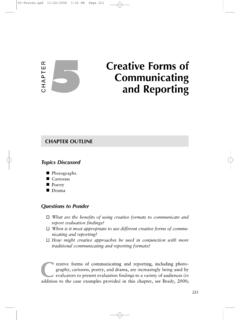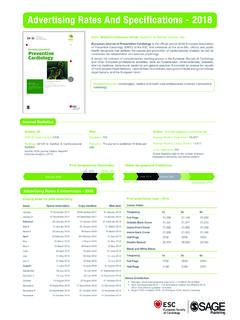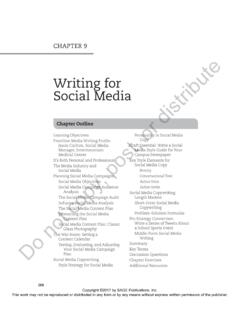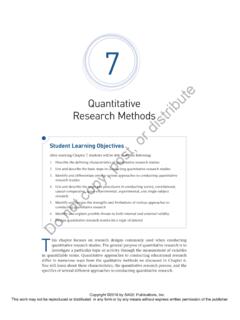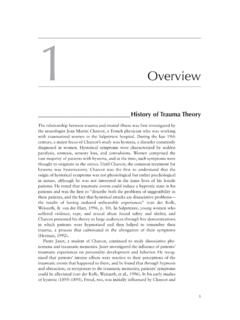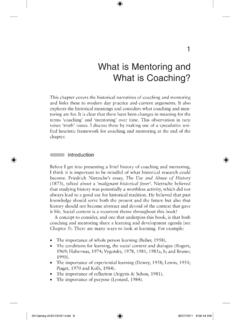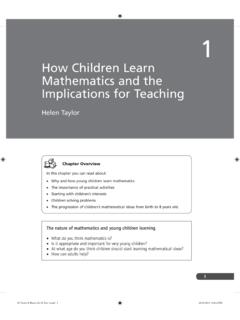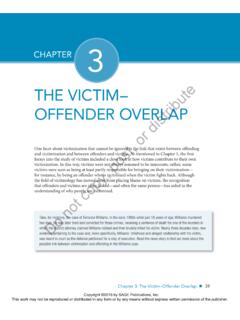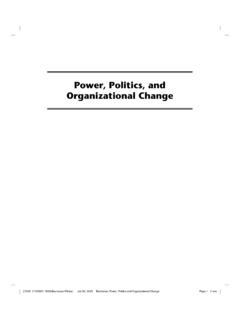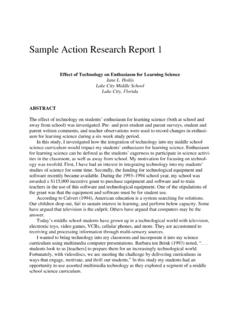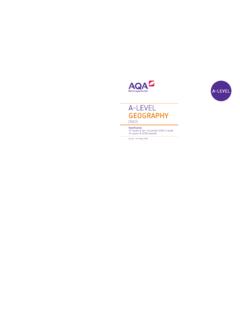Transcription of 1 What Is Academic Language? - SAGE Publications Inc
1 1 1 What Is Academic Language? Language is the fundamental resource or tool with which teachers and children work together in schools. Frances Christie, 2005, p. 2 For the last couple of decades the language education community has been grappling with defining the construct of Academic language and situating it within an assets-based model to ensure the Academic success of linguistically and culturally diverse students. Along come the Common Core State Standards (CCSS) in 2010, and poof, Academic language assumes a front and center position in curriculum design and enactment, impacting every teacher, every day. This chapter summarizes the thinking on Academic language use and its application to schooling. It examines the roles of Academic language, its dimensions and underlying theories, and the developmental nature of language learning.
2 It concludes with a call for educators to recognize the paradigm shift we are currently witnessing and to seize the opportunity to promote social justice for students ROLE OF LANGUAGE IN SCHOOLING AND BEYONDL anguage is perhaps the most powerful tool available to teachers, since language is pervasive in every aspect of the teaching and learning process. Whether it is a nod signifying agreement, a command such as Eyes on me! 2 Academic Language in Diverse Classrooms: Definitions and Contextsor an explanation such as, This is one way to simplify an equation, lan-guage is always a resource for making and communicating serves many purposes in schools. In addition to being a place for social networking and for socializing students into ways of doing school, school is one context for learning. In school, students use language to make sense of the world that surrounds them, and, in the process, they are (1) learning language, (2) learning through language, and (3) learning about language (Halliday, 1993).
3 One unique characteristic of humans is that we never stop learning lan-guage. From birth to age 7, children learn an enormous amount of language. Although this amount declines as students reach age 17 or 18, we continue to learn and enhance the language we need as we navigate through new stages and contexts in is at the center of the learning process; humans learn through language. Language is a way of seeing, understanding, and communicat-ing about the world. Learning in schools and classrooms is largely accom-plished through language. In school, We could virtually say that language is the curriculum (Derewianka, 1990, p. 3).Beginning with the early stages of language learning, children formulate consciously or unconsciously their own rules about how language works. Later, children add new rules and amend old ones so that their sentences and usages resemble the language used by adults and those that surround them.
4 As children learn the language of the home, they learn several different lan-guage styles, which vary according to the setting, the speakers, and the goal of communication. These styles are also called RegistersThe concept of register is typically concerned with variations in language conditioned by uses rather than users and involves con-sideration of the situation or context of use, the purpose, subject-matter and content of the message, and the relationship between the participants. (Romaine, 1994, p. 20)In the study of language, a register is a variety of a language used for a specific purpose and audience in a particular social setting. Registers are simply a particular kind of language being produced within the context of a social situation. Below are three ways of saying the same thing, depend-ing on the relationship between speakers and the circumstance:I would be very appreciative if you would make less be up!
5 3 What Is Academic Language? Throughout the day a person may use several different registers. For example, let s listen in as Nicole, a 37-year-old nurse, uses several (nurse, 37 years old)MessageTo WhomContext That s the optimum, and clinically that s what s advisable. patientwork What s up, Anne? I haven t seen you in years. friendgrocery store Way to go, Rudy, you nailed that one. sonbasketball practice let me know where u r when you have a min. thx, luv u teenage daughtertext message I never had the opportunity to meet your father, but I know you talked highly of him, and I know your loss is great. Our condolences to you and your family. neighborwritten message on a cardIn school contexts, teachers and students also use a variety of regis-ters. Many researchers and educa-tors have made a distinction between everyday and Academic language (Cummins, 1986).
6 Social language is associated with everyday, casual interactions; it s the language we use to order an ice cream, talk with a neighbor, or chat with family mem-bers. In schools, this is the language students use in the playground, caf-eteria, or in the hallway. However, social language is also very much used in classroom dialog, as illustrated in the following examples: Turn to your elbow partner and figure out the answer. (Grade 2 teacher to students) Hold your horses; we are not there yet! (history teacher to high school students). Dunno how to save my work. (Grade 4 student to teacher)Consider this .. What are some of the ways you typically use language during the day? How might you document differences in Academic language use according to the context and with whom you are interacting? What suggestions might you make to increase the rigor of Academic language use within classrooms?
7 4 Academic Language in Diverse Classrooms: Definitions and Contexts That s a cool shirt, Dylan. Did you see the game? (principal to middle school student). Dude, you need to get caught up with your group. (Grade 5 teacher to student).Everyday language is very much a part of classrooms and schools; however, with its colloquial and idiomatic expressions, it can be consid-ered in the Academic range for those students who have not previously been exposed to it. At the other end of the Academic language spectrum is the more formal, specialized register associated with disciplinary material. With today s emphasis on Academic registers, many educators immediately think about vocabulary as the distinguishing feature. Although vocabu-lary is a very important dimension of Academic language, as will become evident in the next sections, it is only one NATURE OF Academic LANGUAGEWhat s hard about learning in Academic content areas is that each area is tied to Academic specialist varieties of language (and other special symbol systems) that are complex, technical, and initially alienating to many learners.
8 (Gee, 2004, p. 3)Although in recent years Academic language has been at the center of many educational efforts, educators and researchers have conceptualized Academic language in different ways. Several recent studies point to teach-ers understandings of Academic language as challenging content-area vocabulary, or hard words ( , Ernst-Slavit & Mason, 2011; Homza, 2011; Lee, 2011; Wong Fillmore, 2011). However, Academic language is a complex concept. The difference in purpose, audience, and context results in clear differences in terms of language use in the selection of words, for-mality, sentence construction, and discourse patterns (Gottlieb & Ernst-Slavit, 2013, p. 2).In this section, we will provide a working definition of Academic lan-guage, explain its importance in fostering Academic thinking, describe the main roles of Academic language, and explain three dimensions or compo-nents that characterize Academic general terms, Academic language refers to the language used in school to acquire new or deeper understanding of the content and com-municate that understanding to others (Bailey & Heritage, 2008; Gottlieb & Ernst-Slavit, 2013; Gottlieb, Katz, & Ernst-Slavit, 2009; Schleppegrell, 2004).
9 Because Academic language conveys the kind of abstract, technical, and 5 What Is Academic Language? complex ideas and phenomena of the disciplines, it allows users to think and act, for example, as scientists, historians, and mathematicians. Thus, Academic language promotes and affords a kind of thinking different from everyday language. As put by William Nagy and Dianna Townsend (2012), Learning Academic language is not learning new words to do the same thing that one could have done with other words; it is learning to do new things with language and acquiring new tools for these purposes (p. 93).Viewing Academic language not as an end in itself but as a means to foster Academic thinking can be very helpful in moving away from a focus on teaching Academic language when it is not contextualized in mean-ingful Academic activities.
10 Along these lines, Zwiers (2008) contends that Academic language serves three interrelated and broad roles: to describe complexity, higher order thinking, and abstraction. Each purpose is briefly summarized in Figure this chapter and book series, we discuss Academic lan-guage as including more than vocabulary or phrases pertinent to the topic at hand. As can be deduced from the above discussion, Academic language necessitates more than knowledge of single words to describe complex concepts, thinking processes, and abstract ideas and relationships. The Academic language needed for students to access disciplinary content and textbooks and successfully participate in activities and assessments involves knowledge and ability to use specific linguistic features associ-ated with Academic disciplines.
